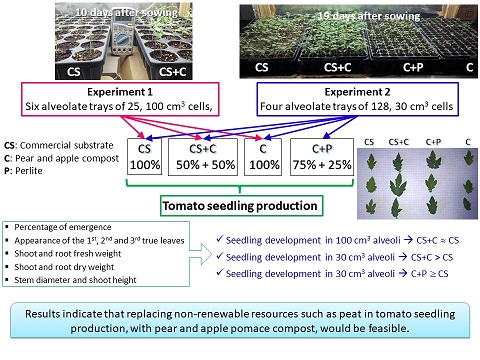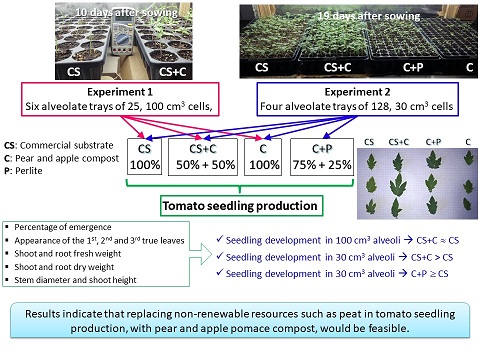Pear and apple pomace compost as an alternative to commercial substrates in the production of tomato seedlings
DOI:
https://doi.org/10.48162/rev.39.013Keywords:
aerial biomass, agroindustry wastes, Lycopersicon esculentum, nutrients, seedling emergenceAbstract

It is important to look for alternative substrates to replace non-renewable resources such as peat used in growing media in horticulture. The aim of this work was to evaluate if the compost of pear and apple pomace could be used as an alternative to a commercial substrate for the production of tomato seedlings. Two experiments were carried out on trays with alveoli of 100 cm3 (experiment 1) and 30 cm3 (experiment 2). In experiment 1, three substrates were used: commercial substrate (CS), mixture of CS and pomace compost (CS+C) and pure compost (C). In experiment 2 a fourth treatment with a mixture of compost and perlite (C+P) was incorporated. The obtained results indicate that the development of the seedlings using CS+C and CS as a substrate was similar in cells of 100 cm3 and higher in cells of 30 cm3. In addition, the growth of seedlings on C+P in relation to CS showed similar or higher values in some variables. These results indicate that it would be feasible to replace the use of non-renewable resources such as peat in the production of tomato seedlings by a product obtained from a residue.
Tomato seedling growth was evaluated on trays with 100 cm3 alveoli and 30 cm3 alveoli on different substrates mixtures: commercial substrate (CS), mixture of CS and pomace compost (CS+C), pure compost (C) and mixture of compost and perlite (C+P).
Highlights
- Seedling development using CS+C and CS as substrates was similar in cells of 100 cm3 and higher in cells of 30 cm3.
- Seedling growth on C+P in relation to CS, showed similar or higher values for some variables such as root dry weight, shoot dry weight, stem diameter and shoot height.
- In 30 cm3 cell trays of the compost and perlite treatment (3:1 v/v), obtained seedling quality would enable a high post-transplant survival percentage.
- Pear and apple pomace compost may be an alternative to a commercial substrate containing peat for tomato seedlings production (Lycopersicon esculentum Mill.).
Downloads

Downloads
Published
How to Cite
Issue
Section
License
Copyright (c) 2021 Revista de la Facultad de Ciencias Agrarias UNCuyo

This work is licensed under a Creative Commons Attribution-NonCommercial-ShareAlike 3.0 Unported License.
Aquellos autores/as que tengan publicaciones con esta revista, aceptan las Políticas Editoriales.










.jpg)




